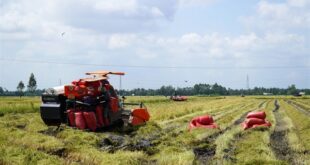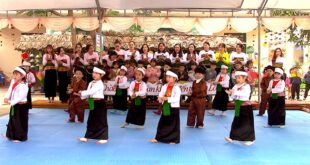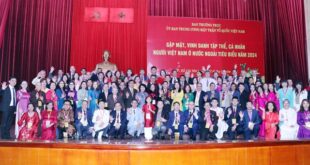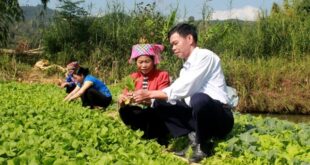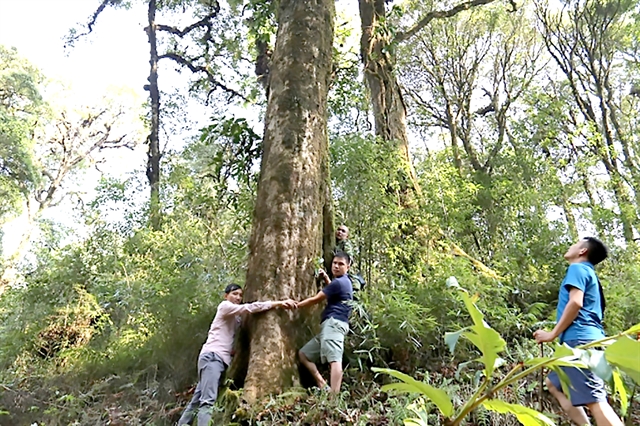
LAI CHÂU — Further exploitation and conservation have been planned for wild tea from Pú Tra Mountain in the northern province of Lai Châu, to build the tea into a cultural icon of the province.
Vũ Đức Mạnh, secretariat of the Mường Khoa Commune Party Committee, said that in the Pú Tra Mountain area, which is located at an altitude of 2,000 metres, is a tea forest with about 2,000 giant ancient tea trees and a countless number of smaller ones.
Local people usually go to the forest to collect tea leaves from the ancient trees for daily use. The tea is the best if picked between March to June, he said.
Seeing the speciality of the tea and increasing demand for it, local authorities, residents and organisations are making a plan for further exploitation and conservation, Mạnh said.
Located just 15 km away from the centre of the commune, Hô Tra village is close to the forest.
It takes villagers half a day to reach the top of Pú Tra Mount where they can find wild tea.
An elderly in the village, Châu A Vảng, said that the big wild tea trees could be about a hundred years old.
“The trees absorbed the wind and rain of the sky and earth, so the buds are thick and green. When drank, it has a cool aroma like early morning dew in the forest, sweet but not acrid. Very few places have such tea,” he said.
“When drinking that tea, our spirit is refreshed and we feel more energetic,” he said.
The had of Hô Tra Village Thào A Phành said that the village is hundreds of years old. Their ancestors, mainly Hmong people, migrated from Sa Pa (in Lao Cai Province) to reclaim their land. The name of the village is reminiscent of the merits of their ancestors, who led the whole family to the new land to live.
“When Hô Tra village was formed, the forest here was full of big trees. According to indigenous people, in the forest, there are many thousand-year-old trees. Some trees can’t be reached and only be seen from afar because there is no road,” he said.
In the old forest, the vegetation layer is tens of centimetres thick and porous, creating a large amount of humus to help cardamom grow above a person’s head.
“Since moving here, people have cleared the fields to plant corn, then grow cardamom, then orchids,” Phành said.
“Seeing the economic benefits, they keep the forest. Now they also receive money to support environmental protection, which make the forest more important to local people’s life,” said Phành.
“The old forest here has ancient tea trees, the body of which are as big as four or five people hugging,” he said, adding that people climbed to the tops of ancient tea trees to pick young buds to bring back to drink.
“Taking a little tea makes people feel better during long forest trips,” he said.
In the early morning, a villager Hạng A Chinh and a few young people get up early to prepare for a trip to the forest to get tea leaves.
There is no path to the old forest where the ancient tea trees are. People have to climb steep cliffs or cross streams covered with green moss.
Any carelessness could make them fall and slip, hitting the big rocks below, Chinh said.
The deeper they go into the forest, the harder it is to cross with plants and thorny branches. However, what they were afraid of most was forest squeakers, Chinh said.
“Now many people know about ancient tea, they really like to drink this kind of tea, so people in the village use part of the collected tea and brought the remaining tea to Tân Uyên town to sell,” said Chinh.
“Once picking a full basket of tea leaves, I come home late at night. If we are unable to get down the mountain in time, we slept in a shack because it’s very dangerous to go into the forest at night,” he said.
Economic benefits
Vũ Văn Mạnh, a representative from a unit that is surveying, researching, exploiting and preserving ancient tea in Tân Uyên District, said that through studies, they found that at the altitude of 1,500-3,000m above sea level, in the communes of Mường Khoa, Bắc Ta, Ho Sỏ and Trung Đồng, there are ancient tea trees that could be up to a thousand years old.
“These tea plants belong to natural tea varieties that have not been researched and evaluated methodically from a scientific perspective. They have valuable medicinal substances as well as economic and cultural values. Therefore, we propose to preserve and develop the brand of ancient tea trees in communes in Tân Uyên district,” he said.
In the link among the three parties – the State, the investor and the people – people will be the main subject for development. The State would develop the association plan while the investor orients the brand name and ensure stable consumption.
Most of the forest land with ancient tea trees is under the management of the Protection Forest Management Board of Tân Uyên district.
The forest land has been allocated to farmers in the communes, allowing them to protect and exploit secondary forest products under the forest canopy, including ancient tea trees. Therefore, up to now, the parties have agreed to establish cooperative production groups in villages in communes, he said.
His enterprises would invest funds to conserve and guide people on methods of exploitation and preliminary processing to ensure the benefits of the associated investment as well as to ensure the uniformity of quality and trade brand name of ancient tea products in the district. —- VnExpress News
- Reduce Hair Loss with PURA D’OR Gold Label Shampoo
- Castor Oil Has Made a “Huge” Difference With Hair and Brow Growth
- Excessive hair loss in men: Signs of illness that cannot be subjective
- Dịch Vụ SEO Website ở Los Angeles, CA: đưa trang web doanh nghiệp bạn lên top Google
- Nails Salon Sierra Madre
 VnExpress News The News Gateway of Vietnam
VnExpress News The News Gateway of Vietnam
